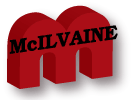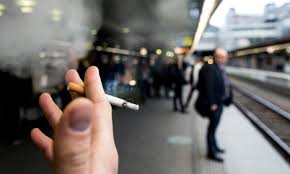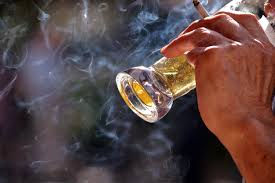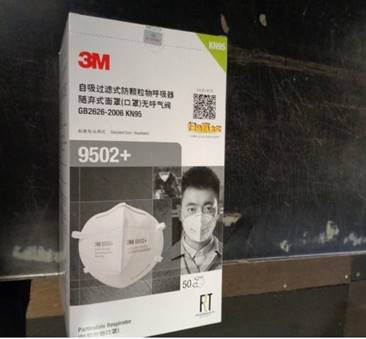
Coronavirus Technology Solutions
May 6, 2020
New Coronavirus Strain Creates Challenges
Do we Need Masks with Valves for Certain People
and Certain Situations?
Filtration Webinar on May 5 also Provides
Coronavirus Insights
Signature Health Care is Using UV to Sterilize
Masks
Turkey has the best EU ICU Capacity at 40 beds
per 100,000 People
Pressure Sensors are Important to Keeping Rooms
Isolated
CWS Provides Guidance on Coronavirus for
Cleanroom Operators
Should Cleanroom Operators Treat Coronavirus as
Part of a Box Within a Box?
Cigarette Smoke is Similar in Particle Size to
Some of the Coronavirus Aerosols
Modify Restaurants and Subways as if you are
Protecting Against Cigarette Smoke
China is Expanding Meltblown Capacity Rapidly
but with Difficulty Controlling Quality
Cloth Masks do not Protect Wearer or Others
Restaurant Air Flow has to be Redesigned
to Allow Them to Open Safely
______________________________________________________________________________
New Coronavirus Strain Creates Challenges
A new, recently discovered strain of the
coronavirus has a leading researcher concerned
that it will present a difficult challenge to
the vaccines currently under development.
Dr David Monterfiori of Duke University was
involved in a study with a team out of the Los
Alamos National Laboratory that has identified
the new strain. They said the new strain may be
more contagious but is no more deadly the other
strains of illness.
A viable vaccine is one of the key elements
toward responding to the disease in the future
and several tests are currently in process. Many
researchers believe another severe COVID-19
outbreak could take place this fall including
UCSF epidemiologist Dr. Gene Rutherford. “We’re
gearing up now, our big concern is about a
second wave in the fall,” he told KPIX 5.
Monterfiori’s research may indicate that the
illness will be driven by the new strain and
that it is already here. It became very evident
that this new mutant form of the virus was
spreading rapidly,” he said. The mutation
involves the spikes that stick out from the
surface of the virus. “That’s how it attaches to
cells and gets into cells,” Monterfiori said.
If you are already infected with COVID-19,
that’s the spot where the antibodies would block
the virus from infecting you again. But your
body’s reaction may not be strong enough when it
comes to the new strain. Monterfiori worries
about how it will impact how a vaccine under
current development may combat the illness.
“That’s the protein that’s in all the vaccines
right now,” he said. “And so we’re concerned
that the mutation in this new form of the virus
will be a problem for the current vaccines.”
Do we Need Masks with Valves for Certain People
and Certain Situations?
Two Chinese boys dropped dead within a week of
one another while wearing face masks during gym
class. The students, who were both 14, were each
running laps for a physical examination test
when they suddenly collapsed on the track. One
student at Changsha’s Xiangjun Future
Experimental School in Hunan province had been
wearing an N95 respirator and running a
1,000-meter exam when the fatal incident
occurred. It’s unclear whether an autopsy had
been ordered.
Though it’s not known whether the masks played a
role in either death, several schools in Tianjin
and Shanghai have canceled physical education
exams, according to the report.
These incidents raise the question as to whether
N95 masks with valves should be substituted for
those without valves under certain conditions.
One would certainly be heavy exertion.
Another would be individuals who have underlying
conditions e.g. asthma where breathing is more
difficult that it would be for the average
person.
Filtration Webinar
on May 5 also Provides Coronavirus Insights
A webinar held by the Waterloo Filtration
Institute on Tuesday
provided a good summary of the filtration
industry and brief insights on the coronavirus
challenge by Paul Marold, president of Lydall,
and Val Hollingsworth, CEO of Hollingsworth &
Vose. Bob Mcilvaine was also a speaker.
Details are found at
Signature Health Care is Using UV to Sterilize
Masks
Signature Healthcare Brockton
Hospital is using ultraviolet light to sterilize
and reuse N95 masks to care for patients,
including those who have tested positive for the
coronavirus.
Under normal circumstances,
hospital staff wouldn’t reuse personal
protective equipment, said Stephen Borges, vice
president of operations for Brockton Hospital.
But given the increased need for gear to treat
coronavirus patients and a nationwide shortage
of it, the hospital wanted to find a way to
reprocess masks and make them available to
staff.
“The fact that we’ve
processed them and packaged them up makes it a
little easier to reuse them,” he said. “It gives
the staff some sense ... It’s not optimal, but
it’s much better to be able to reuse the masks
and that the equipment to do this is available,”
said Borges.
But given the increased need
for gear to treat coronavirus patients and a
nationwide shortage of it, the hospital wanted
to find a way to reprocess masks and make them
available to staff.
Turkey has the best EU ICU Capacity at 40 beds
per 100,000 People
Turkish health care, armed with a pandemic
preparedness plan issued long before the
outbreak emerged in the region, has been hailed
by experts for offering a good, timely response
to the pandemic. Turkey also boasts an intensive
care unit bed capacity that is the largest in
Europe, with 40 beds per 100,000 people.
Recently, the country started unveiling new
hospitals whose construction was accelerated to
help combat the outbreak. Last month, the
Başakşehir City Hospital in Istanbul was
partially opened to serve as a pandemic hospital
while construction of two new hospitals in the
city, each with a 2,000-bed capacity, was
launched last month. The construction is
expected to wrap up in 45 days. Also in March,
authorities unveiled a new hospital in the
city’s Okmeydanı district with more than 600
beds and 99 high-tech intensive care units.
Sancaktepe Şehit professor İlhan Varank of the
Istanbul Training and Research Hospital is among
those facilities turning to negative pressure
rooms to further stem the tide of the virus. The
pandemic hospital admitting the greatest number
of patients in Istanbul, the facility is staffed
with 1,900 personnel working day and night and
has converted a significant number of areas,
including 16 surgery rooms and 75 intensive care
beds, into negative pressure rooms. The rooms
offer a relief for the staff of the hospital,
which has admitted nearly 60,000 patients since
March, including about 11,000 suspected
coronavirus cases. Along with handling a barrage
of COVID-19 patients, staff have continued to
carry out surgeries, including on those
suspected of having the virus. So far, about 300
patients, suffering from other diseases have
been operated on.
Pressure Sensors are Important to Keeping Rooms
Isolated
Many facilities are geared to meet minimal CDC
and Joint Commission guidelines around isolation
rooms. However, there is a huge opportunity for
hospitals to update the technology that ensures
proper isolation room pressurization. One of the
most resourceful methods to verify pressure
measurements is through real-time pressure
monitoring and alert notifications.
The SensoScientific Differential Pressure
Monitoring System is designed to meet CDC, USP,
ISO/IEC, and Joint Commission compliance
standards. The latest OTA Series Differential
Pressure Sensors enter a low-power mode between
readings, ensuring accuracy, reliability, and
product longevity.
These devices piggyback off
existing Wi-Fi to upload readings to
SensoScientific Cloud, accessible from any
internet-ready device. Through the cloud, the
user can access unlimited data records, generate
reports, view calibration certificates, and
receive 24/7 alert notifications the moment
isolation room pressure exceeds the recommended
threshold.
Loggers can be installed according to IQ/OQ/PQ
standards and are a low maintenance solution to
pressure monitoring and regulatory compliance.
✓ Positive
and negative airflow
✓ Range:
+/- 0.5 inH2O
✓ Accuracy:
+/- 0.01 inH2O
✓ Uni-
and bi-directional pressure measurement
✓ Real-time
alert notifications
✓ IQ/OQ/PQ
compliant
✓ ISO/IEC
17025
Differential Pressure monitoring systems help
prevent the spread of infectious diseases and
maintain sterile work environments by actively
measuring pressurized airflow between a positive
or negative buffer room and the ante-room.
Wide-range wireless differential pressure
sensors monitor bi-directional and
unidirectional pressure and use Wi-Fi to send
information to the cloud. It
notifies
via email, SMS text, voicemail, fax, or
pager when negative or positive pressure rooms
are not maintaining proper readings.
CWS Provides Guidance on Coronavirus for
Cleanroom Operators
The CWS Cleanroom blog observes that the
coronavirus SARS-CoV-2 poses great challenges
for cleanroom operators. Particularly in
cleanrooms, it is important that viruses and
bacteria cannot transmit via employees or their
clothing. But can this really be achieved? Where
are the pitfalls and how can they be countered?
Dr. Rüdiger Laub, Head of the Cleanroom Academy
was interviewed
to provide the following information.
Dr. Laub, is it possible to prevent SARS-CoV-2
from entering the cleanroom?
No - the penetration of viruses into cleanrooms
cannot be completely prevented.
However, much can be done to prevent the virus
from finding its way into the cleanroom - for
example, by wearing appropriate cleanroom
clothing and accessories such as goggles, gloves
and other protective materials. And of course,
making cleanroom users aware by training and
instruction. The risk potential is highly
dependent on their behavior. However, even with
the utmost caution, there will never be 100%
safety. Because the weak point is the cleanroom
user. Due to the long incubation period,
employees could potentially carry the virus, and
thus transmit it while not feeling ill, or
perhaps haven't felt any symptoms yet.
Provided that sufficient testing capacity is
available, cleanroom personnel could be tested
preventively in so-called "critical
infrastructures" - for example, in cleanrooms of
hospital pharmacies - at very short intervals or
if suspicion exists. Basic principle: Early
detection - early removal from processes -
reducing risk.
Let's move on to the topic of prevention: What
additional protection options do you currently
recommend for cleanroom personnel to prevent the
coronavirus from being transmitted into the
cleanroom?
Basically, the airlock processes, cleanroom
clothing, behavior, as well as robust cleaning
and disinfection measures form very effective
barriers against the penetration of viruses;
however, SARS-CoV-2 is particularly treacherous
and demands further measures. In this
exceptional situation, more protection is
advisable. I therefore recommend the following
supplementary measures to keep the risks to a
minimum: As a matter of principle, only one
person should currently be in the airlocks
leading directly to the production areas.
Another starting point is protective clothing -
for example face protection. This should now
also apply in the cleanroom classes where this
is currently not provided as standard - i.e.
also in the GMP cleanliness classes D and C /
ISO cleanliness classes ISO 9 to ISO 6. Since
the virus can be spread further via the hands,
gloves are currently also a must in all
cleanrooms - even if it is not provided for the
normal protocols for that cleanroom class.
Additional protection is provided by cleanroom
wipes, which can be used to clean surfaces and
other items as required.
The remainder of this interview can be found at
Should Cleanroom Operators Treat Coronavirus as
Part of a Box Within a Box?
The CWS interview with Dr Laub talks about
certain measures for coronavirus mitigation to
be taken prior to entering the cleanroom such as
masks and a procedure to pass through the
initial airlock. Should operators be thinking of
the cleanroom as a box within a box? The big box
is the Class 500,000 area surrounding the
cleanroom. What if this is reduced to Class
100,000?
What if every employee in street shoes
has to step on a UV/Ozone foot sanitizer? What
if the mask protocol in the larger box and in
travel to and from work is coordinated with a
mask exchange program at the plant entrance?
As the McIlvaine Alert shows, an N95
quality mask is needed due to the fact that much
of the virus transmission is through small
aerosols. So the Cleanroom operator can provide
masks for travel to and from the cleanroom.
Cigarette Smoke is Similar in Particle Size to
Some of the Coronavirus Aerosols
In an AFS publication, Wilson Poon of W.L. Gore
provided analysis of cigarette smoke particle
size.
Cigarette smoke is an important aerosol in the
air filtration industry and research. It is an
unwanted aerosol and therefore there are many
applications for air filtration (ex. cigarette
filters, residential and commercial ventilation
filters, home air cleaners).
Cigarette smoke is especially important to air
filter performance for several reasons. First,
the size of cigarette smoke particles are near
the most penetrating size of air filters
(100-300 nm). As a result, they are relatively
difficult to capture. Secondly, the efficiency
of electret filter is severely degraded by the
semi-volatile cigarette particles. It is
believed that they form a film on the fiber
surface and effectively shield or remove the
charges. If this occurs, the electrostatic
efficiency of the filter suffers. The remaining
mechanical efficiency is usually poor because
electret is a depth filter and the fiber size is
relatively large. Furthermore, a cigarette can
produce a large amount of aerosol quickly.
Imagine a room with several cigarette smokers!
Whereas large particle (>5 micrometer diameter)
tends to settle down by gravity quickly,
cigarette smokes are relatively stable and their
lifetimes can be on the order of days or weeks.
Therefore, cigarette smoke can be viewed as a
stringent test for air filters.
The paper linked below provides
the results of particle size measurements
done by previous researchers. The count median
particle size is between 0.1 to 0.3 μm, near the
most penetration particle size of high
efficiency particulate arrestor (HEPA) filters.
For depth filtration media like microfiberglass,
the loading of smoke particles would not be
detrimental because the oil droplets can wet the
fibers and spread out. For microporous membrane,
the loading of smoke particles can have a
detrimental effect on the pressure drop. Due to
surface filtration, the oil droplets are
collected near the surface. As the oil
accumulates on the surface, it chokes off the
airflow. It is therefore not recommended to use
microporous membrane in environments with
cigarette smokers.
https://www.afssociety.org/cigarette-smoke-size-distribution-and-effects-on-filters/
Modify Restaurants and Subways as if you are
Protecting Against Cigarette Smoke
McIlvaine has questioned the CDC guidance to
meat processors to install partitions around
workers. Further questions are raised about
social distancing due to the small size of
coronavirus aerosols. The article above analyzes
the size of cigarette smoke. Numerous articles
in this Alert
show that a significant quantity of virus
is transmitted in aerosols or on particles of
similar size to cigarette smoke.
McIlvaine summarized this in
Laminar Flow Not Partitions and Masks Not 6 ft
Distance are the New Recommendations
It is well understood that cigarette smoke will
move around partitions and drift much farther
than six feet.
Unidirectional
flow, HEPA filters and N95 masks are the answers
for many situations.
One would be subway stations.

Another would be restaurants where the guidance
has been to reduce occupancy to 25 percent.
As can be seen from the smoke filled bar
below, distancing is not an effective solution.

In a study of coronavirus transmission in a
restaurant in Southern China the biggest factor
was the air flow pattern. Those far away from
the transmitter but in the air flow pattern of
the air conditioner became infected. Those close
but not in the air stream did not. So the answer
is HEPA filtration and unidirectional air flow
away from individuals such as vertical downward
flow. Restaurants could invest in a few fan
filter units at $2k each and seat more people at
less risk.
China is Expanding Meltblown Capacity Rapidly
but with Difficulty Controlling Quality
In China, the largest exporter of medical masks
in the world, about 4,000 new companies have
registered to manufacture or trade melt-blown
fabric since the beginning of the year,
according to Tian Yan Cha, an online service
tracking companies' credits and registries. Last
year, only about 300 new companies registered
melt-blown businesses.
Yangzhong, a city of about 340,000 residents in
Jiangsu province, became a marketplace for
melt-blown fabric seemingly overnight.
Machines that used to produce other types of
nonwoven fabric were converted to make the
melt-blown fabric. Most of these machines came
from nearby cities such as Zhangjiagang,
about 100 miles away from Yangzhong
Zhe Huang, who manufactured nonmedical masks in
Zhangjiagang, said it’s not easy to make
medical-grade masks. They require strict
production conditions such as a dust-free work
site and filters that meet medical standards.
To make the filter fabric, thousands of solid
polypropylene granules are melted and extruded
from nozzles into high-velocity hot air streams,
forming fine filaments, “the size of your hair,”
said Gajanan Bhat, who heads the Department of
Textiles, Merchandising and Interiors at the
University of Georgia. Those ultra-fine fibers
are bonded and collected on a moving screen,
becoming a sheet of webs. “It’s like a spider
web; multiple layers of spider webs,” said Bhat,
who has published extensive research on
melt-blown fabric and the spunbond fabric that
sandwiches it in masks.
By April 9, local media had caught on to what
was happening in Yangzhong and took a critical
stance: “The myth about being a billionaire from
the melt-blown fabric encourages farmers to stop
their farming, workers to quit their stable
jobs and companies to throw away their
reputation to join this gold rush,” the
Yangzhong Daily Newspaper wrote on its front
page.
Public signs of trouble for the startups
appeared two days later, on April 11, in a news
release from Yangzhong’s emergency management
bureau. It accused a melt-blown company of
violating the Production Safety Law of the
People's Republic of China. The agency said the
company didn’t post obvious safety warnings on
its air compressor and hadn’t put its employees
through safety training.
The next day, the emergency management agency
found a hotel in Jingkai District of Yangzhong
had violated fire ordinances by using some of
its rooms for manufacturing the melt-blown
fabric. The hotel, it reported, was temporarily
sealed up and under investigation.
Almost as quickly as the industry appeared in
Yangzhong, it disappeared. Mounting concerns
about the quality of the product brought its
melt-blown fabric manufacturing to a grinding
halt.
A 95% filtration rate is required for
medical-grade surgical masks, according to the
American Society of Testing and Materials. High
protection masks such as N95s should have a rate
of 98% or higher.
Yangzhong’s Administration for Market Regulation
randomly tested fabric from eight manufacturers
of melt-blown fabric in early April. When the
agency's report came out, five of the samples
met neither standard, and only two could be used
for high-protection masks. Three were not even
close, filtering out 45% or less.
On April 14, the city noted in a news release
that it had been pushing to overhaul illegal
melt-blown production since late March and
issued warnings to 225 enterprises making or
selling “three-no” textiles – products without
production date, name of manufacture and
sanitary certificate.
The next day, the city went further, shuttering
867 melt-blown businesses. Wei was surprised to
see his hometown pop up as a hot search on Weibo
for a post reporting that “#All Yangzhong
companies that produce the melt-blown fabric
shut down for rectification.”
Wiping out the melt-blown industry in Yangzhong
probably won’t be the end of it, according to
dozens of experts in the industry contacted by
USA TODAY, including manufacturers, investors
and traders. The demand is too great.
Even as the city cracked down on all the fabric
production, melt-blown makers loaded their
machines into their car trunks and transferred
them to nearby cities.
In February, the average retail price for the
fabric in China increased tenfold, from 40,000
yuan per ton to 400,000 yuan per ton, according
to China Merchants Securities. Before the
COVID-19 pandemic, the market price for such
fabric in China was 20,000 yuan – about $2,800 –
per ton, according to China's State
Administration for Market Regulation.
Masks that leave China through official channels
go through extensive certification intended to
prevent exports of substandard material.
Entering the USA adds another layer of scrutiny.
There are other routes.
Relatively small orders from individuals – or
even larger organizations – can be sent through
the mail.

Last month 25,000 counterfeit masks from China
were found at a DHL hub in Kentucky.
Cloth Masks do not Protect Wearer or Others
In an interview with Infection
Control Today®, Lisa Brousseau,
ScD, expert on infectious diseases said that the
CDC’s suggestion that cloth masks offer any kind
of protection flies in the face of the data. “It
was clear that even surgical masks weren’t
working in healthcare settings or controlling
COVID-19,” Brousseau said.
Brousseau also said: “Surgical masks, I decided,
based on the literature, might have a role as
source control for people who have symptoms. Say
if they’re staying home and they have some
symptoms. They shouldn’t be something you’d wear
if you have symptoms going out into the public
because you shouldn’t be going out into the
public service. But it’s a good option for
patients to wear in healthcare settings where
they—especially for those who are experiencing
symptoms—to what I would call diminish the viral
load.”
She added that “at the end of the day, the only
thing that provides personal protection for the
person wearing the mask is a respirator.”
https://www.infectioncontroltoday.com/mask-respirators/cloth-masks-are-useless-against-covid-19
Restaurant Air Flow has to be Redesigned
to Allow Them to Open Safely
Previous McIlvaine articles discuss using
ceiling fan filter units in the restaurant
dining area and then downward laminar flow of
HEPA filtered air. The extent to which
this air could move at floor level and
then become part of the kitchen exhaust would be
beneficial in terms of
minimizing viral contact.
Here is the system which has been offered
by Trane and needs to be revised.

